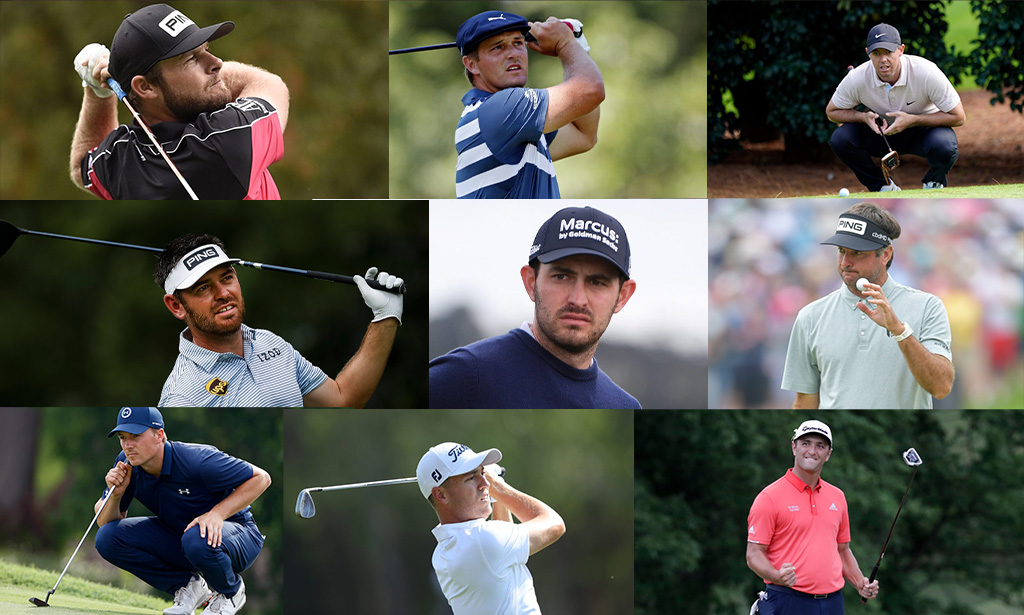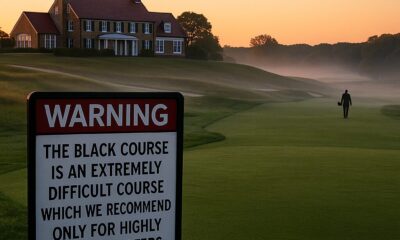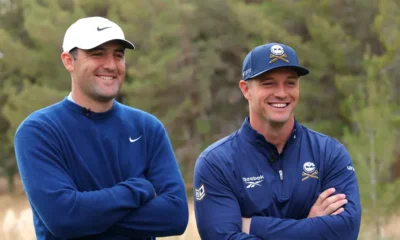Blog
Our Favorite PGA Tour Players to Watch – and Some We’d Skip

Most PGA Tour events are kind of like a two for one deal. The first two rounds begin on Thursday and golfers must make the cut in order to continue on in the event. This is proceeded by the big weekend excitement that golf fans are sure to be near a television to watch. Plus, that prize money is nothing to turn your nose up at either. This is the pros after all. Top earners are walking away with seven figures, easy.
Of course, all of that big money would not be possible if it weren’t for the network broadcasts. As we’ve especially learned during Covid, televised sporting events hold a lot of value. With even more golf fans tuning in from the comfort of their living room, they are willing to pay for that subscription to be able to tune into the action. The PGA Tour’s relationship with networks is more important than ever. The golfer’s themselves don’t come close to bringing in enough money to even touch the payout that live coverage can provide.
The only pro who could claim that title is Tiger Woods. After his horrific car crash at the beginning of the year, we haven’t seen much of the GOAT. He hasn’t even announced plans to come back any time soon.
Whereas Thursday and Friday’s rounds offer a rapid-fire succession of golf shots to viewers, Saturday and Sunday take on a very different dimension. The focus shifts to those atop the leaderboard. This is where we really get to know the golfers. How their facial expressions tell us a little about what is going on inside their head. The shifts in their body language when they are feeling the pressure. We really get to know their quirks. If a player is doing particularly well, TV cameras will have us invested in on player for well over an hour.
As a disparate audience, we draw conclusions. These are based on our own experiences and despite our lack of professional training. We judge the players based on this persona that we have been deciphering on TV. Because some players are easier to like than others, whether that appeal comes from a swing full of power and grace, an everlasting smile, some crowd interaction or a simple appreciation for one’s intense determination.
As a result, we are able to read the golfer’s thoughts and feelings closer than other professional athletes we analyze from our couch. With some invaluable help from a half-dozen pairs of eyeballs and my own marginal sense of perspective, what follows is an assessment of nine marquee players, each of whom has been assigned a “watchability” rating. Using the Bo Derek scale (10 for best, 1 for worst), our subjects are graded for their on-course deportment and assorted observational factors that add to (or detract from) the viewing experience.
This is not a ranking. Just a subjective look at the men who make the game so interesting.
Rory McIlroy — 9 out of 10

The victory in Vegas last weekend makes Northern Ireland’s finest the perfect leadoff hitter. McIlroy maintains a rapid pace of play that a lot of other golfers on Tour can’t match. He makes some ridiculous course-management decisions at times, but that’s not a negative. When things are going well, he jaunts down the fairway like a 9-year-old kid. When they’re not, he wears it on his face like few others. Sadness, not anger. He is incapable of gloating or showboating. Polite but outspoken. Two steps above gifted but flawed beyond explanation. A wonderful asset to the game and one of the more enjoyable players to watch.
Patrick Cantlay— 6 out of 10

His businesslike approach obviously paid off handsomely in 2021, although I prefer the fiery, fist-pumping version of Cantlay we saw at the Ryder Cup. He is unabashedly slow on the greens, and that shuffle of his feet over a putt can leave a fella feeling seasick, but he holes so many bombs that you feel thankful he won’t need another 90 seconds to knock in the next one.
Jordan Spieth — 5 out of 10

He talks to his golf ball more than he talks to his wife, or anyone else, for that matter. This typically happens as his ball sails off and he sees that it is most certainly not headed in the direction he intended. Tiger Woods has been found guilty of the same crime, but his ball rarely disobeyed his command. Spieth is probably the most verbally animated player on the Tour, which certainly can grate on a viewer’s nerves after a while. That said, his short game alone is reason enough to tune in and enjoy.
Tyrrell Hatton— 8.5 out of 10

When Sergio Garcia gets angry, his behavior is considered petulant, mainly because it is. Hatton’s temperamental outbursts qualify as an amusing form of self-abuse. He becomes so unhappy with himself that he appears ready to quit the game, then makes three consecutive birdies and breaks out the most apologetic grin known to golfkind. If England’s most tenacious grinder ever takes to fatherhood, you can bet your life his kids will behave themselves when daddy’s home.
Happy 30th birthday to the always entertaining @tyrrellhatton. May the mics get hotter as Tyrrell gets older. pic.twitter.com/velVJ40biW— Skratch (@Skratch) October 14, 2021
Bubba Watson — 3 out of 10

You don’t need a degree in psychology to know how Bubba’s day is going. When he’s missing putts, which isn’t all that uncommon, Watson’s dramatic reactions come with a level of authenticity that would have inspired Sir Laurence Olivier. Astonishment. Bewilderment. Injustice. Watson’s collection of grim faces are the stuff of a thousand conspiracies, but the big fella can still shape his ball like nobody’s business. Don’t cry for Bubba. He’ll probably miss one from the same distance on the next hole.
Louis Oosthuizen — 8 out of 10

Beyond owning the smoothest move in every town he visits, the gentle South African has taken his close-but-no-cigar status like a man. And thank goodness, because his career of late has been plagued by a severe stogie shortage. He’ll never be a fan favorite because he doesn’t do cartwheels after making a 15-footer and he doesn’t win tournaments — he’s still 0-for-America — but Oostie is an under appreciated, overlooked commodity from a country that hasn’t exactly been burning up the world stage in recent years. Think of him as the anti-Bubba.
Bryson DeChambeau — 1 on some days, 10 on others

Oh, where do we start? He drives it 380 yards without tearing a pectoral muscle, blames everyone but himself when things go wrong, says some of the dumbest things since Jethro Bodine but still carries himself like the smartest guy in every room he enters. Not for nothing, DeChambeau is also the only active golfer who truly moves the needle—a guy capable of adding 5,000 spectators on any given week or boosting the Tour’s rigid TV ratings. Love him or loathe him, he’s a man of impact. People can’t take their eyes off him.
Justin Thomas— 3 out of 10

Clearly one of the game’s most talented players, Thomas can’t seem to see the forest for the trees. He has won some big tournaments but has taken himself out of others with an allergy to adversity that seems to grow more acute each year. The woe-is-me thing simply doesn’t work at the game’s highest level. He’s a handful and a half when everything’s working, but a lot of bad things happen on a golf course. You deal with them. If JT possessed the inner fight that drives his close buddy Spieth, he’d win six times a year.
Jon Rahm — 9 out of 10

While we’re on the subject of disposition makeovers, let us pay tribute to the year’s most successful competitive lobotomy. Rahm might not have won the U.S. Open if he hadn’t diverted from his hotheaded ways, a change brought on by the birth of his first child and the COVID-19/forced withdrawal that cost him the Memorial, but it’s hard to envision a dude with such a short fuse emerging triumphant at golf’s ultimate battle of attrition. He has always been a big boy physically, but in 2021, Rahm added another 20 pounds of emotional muscle.
He is bright, exceptionally well-spoken and clearly thankful for the opportunity life has given him. Americans have always been hesitant to embrace foreign golfers as one of their own. Rahm is on a brisk pace to become the most popular international player of all-time.
This article originally appeared on SI.com
Blog
When Golf Meets Supercars: The World Series of Golf Takes Over Skip Barber’s Mexico Resort
World Series of Golf partners with Skip Barber Racing for a two-year luxury sports series at Gran Reserva, Mexico – where championship golf meets supercars starting April 2026.

Picture this. You’re standing on the 18th green at Gran Reserva, Mexico, finishing a round of championship golf with the World Series of Golf’s signature betting format still buzzing in your veins. The sun’s dropping low. Your heart’s still racing from that final putt.
And tomorrow? You’re driving a McLaren on Skip Barber’s brand-new racetrack.
Two Sports, One Unforgettable Weekend
The World Series of Golf just announced something we’ve never seen before. A two-year partnership with Skip Barber Racing School that transforms their new Mexican resort into the ultimate luxury sports destination. It’s not just golf. It’s not just racing. It’s both, wrapped into an experience that redefines what a sporting weekend can be.
Starting in April 2026, Gran Reserva becomes ground zero for a completely new kind of event.
Year One: The Foundation
The first year lays the groundwork. You’ll compete in the World Series of Golf championship using their patented tournament format – the one that adds poker-style betting mechanics to traditional stroke play and turns every hole into a strategic showdown. High stakes. Real tension. Golf the way it was meant to be played.
But here’s where it gets interesting. While you’re playing, Skip Barber’s building their racetrack right there on the property. You’ll see construction crews working on what will become one of North America’s most anticipated racing circuits. State-of-the-art simulators give you a taste of what’s coming, letting you experience the thrill of motorsports between rounds.
VIP receptions. Celebrity appearances. Curated culinary showcases that match the caliber of the competition. It’s an invitation-only event designed for people who expect excellence and aren’t willing to settle for anything less.
Year Two: The Payoff
Then 2027 hits. The track is finished. And suddenly you’re not just imagining what it’s like to drive a supercar at speed – you’re actually doing it.
McLaren. Ferrari. Mercedes. Lamborghini. Take your pick and put it through its paces on a circuit designed by people who’ve spent over 50 years teaching professional racers how to extract every ounce of performance from a machine. Skip Barber doesn’t mess around when it comes to motorsports education, and this track reflects that pedigree.

You’ll stay in exclusive luxury accommodations at Gran Reserva, network with athletes and industry leaders, and experience both golf and racing at the highest possible level. All in one place. All in one unforgettable weekend.
Why This Matters
Michael Berg, CFO of Skip Barber Racing School, called it perfectly: “Guests will see the racetrack under construction during our first event and then drive world-class vehicles on it the following year.”
That’s the hook. You’re not just attending an event. You’re watching it evolve. You’re part of the story from day one, and by year two, you’re living the payoff.
Robert Davidman, CEO of the World Series of Golf, added this: “This partnership unites golf and motorsports in an elevated format that caters to international fans seeking competition, luxury, and adventure.”
Competition. Luxury. Adventure. Three words that sum up what makes this special.
Why Sponsors Are Paying Attention
Here’s what makes this different from every other golf tournament trying to get your marketing dollars.
The World Series of Golf’s patent-protected format keeps spectators glued to every shot. Shot-by-shot wagering. Antes that double every three holes. Strategic decisions that matter as much as swing mechanics. It’s golf designed for television, and television designed to keep people watching.
Add Skip Barber Racing to the mix and you’ve got something networks actually want to cover. Over 40 hours of TV coverage. More than 15 million media impressions. Five million-plus social media reach. This isn’t a local tournament hoping for some local news pickup. This is a broadcast-ready event with an audience that’s already paying attention.
The demographics tell the rest of the story. You’re reaching affluent golf enthusiasts who also appreciate high-performance automobiles. International travelers who think nothing of flying to Mexico for a weekend of luxury sports. Decision-makers and industry leaders who network at VIP receptions and actually have the authority to sign deals on the spot.
Title sponsorship gets you naming rights, eight playing positions, and premium TV exposure throughout the broadcast. But even smaller packages deliver value. Hole sponsors get exclusive on-course branding and social media mentions for ten grand. Golf cart wraps guarantee TV and photo exposure because every shot of the tournament includes your brand.
The opportunities are limited by design. Only 18 hole sponsors. Three presenting sponsors. One title sponsor. Once they’re gone, they’re gone.
Want the details? Check out the full sponsorship packages at wsg.golf/sponsorship.
The Bottom Line
This isn’t your typical golf tournament. It’s not your standard track day either. It’s something entirely new – a two-year luxury sports series that gives you the best of both worlds and raises the bar for what a sporting experience can deliver.
Year one plants the seed. Year two delivers the harvest. And whether you’re attending as a player or partnering as a sponsor, you’ll be there for both.
For player inquiries, contact events@skipbarber.com. For sponsorship opportunities, reach out to sponsorship@wsg.golf. These events are strictly invitation-only, and opportunities won’t last long.
Golf and supercars. Mexico and motorsports. The World Series of Golf and Skip Barber Racing School.
This is going to be something special.
Blog
Empowering the Next Generation: The Impact of Youth Golf Programs on Shaping Future Golfing Stars
As we tee off into the 21st century, golf, the age-old sport of precision and patience, is witnessing a remarkable transformation.

The Rise of Youth Programs: Unleashing the Potential of Next-Gen Golfers
As we tee off into the 21st century, golf, the age-old sport of precision and patience, is witnessing a remarkable transformation. The sport, once considered a domain of the mature and affluent, is now attracting a younger demographic like never before. The driving force behind this shift? The rise of youth golf programs.
These youth-oriented initiatives are not only making golf more accessible to younger generations but are also nurturing the next wave of golf superstars. So, grab your clubs, and let’s explore how these programs are changing the face of golf and paving the way for next-gen golfers to take center stage.

The Emergence of Youth Golf Programs
In the past, golf was often perceived as a sport for the elite, with limited opportunities for young players to learn and develop their skills. However, the landscape has dramatically changed in recent years, thanks to the emergence of youth golf programs.
These programs are designed to introduce children and teenagers to the sport, provide them with necessary training, and help them develop their skills. From local clubs offering golf lessons for kids to national organizations like The First Tee and PGA Junior League, these initiatives are making golf more accessible to younger generations.

The Impact of Youth Programs on the Golf Industry
Youth golf programs have had a profound impact on the golf industry, contributing to its growth and diversification. Here’s how:
- Increasing Participation: Youth programs have significantly boosted golf participation rates among young people. According to the National Golf Foundation, more than 2.5 million kids aged 6-17 played golf on a course in 2019, a 20% increase from 2011.
- Creating Diversity: Youth programs are also making golf more diverse. They are reaching out to children from different socio-economic backgrounds, providing them with opportunities to learn and play golf.
- Developing Talent: These programs are proving to be a breeding ground for future professionals. Young golfers like Jordan Spieth, Rickie Fowler, and Lexi Thompson, who were part of youth programs, have gone on to make their mark in the professional arena.
- Skill Development: These programs provide kids with comprehensive golf training, helping them develop technical skills like swing mechanics, putting, chipping, and bunker play. They also focus on strategic aspects like course management and decision making.
- Character Building: Golf is not just about technique; it’s also about character. Youth programs emphasize life skills such as honesty, integrity, sportsmanship, and perseverance – values that are integral to golf and life in general.
- Competitive Exposure: Youth programs also provide young golfers with competitive exposure through tournaments and leagues. This exposure helps them understand the competitive nature of the sport, learn to handle pressure, and develop a winning mentality.

How Youth Programs are Nurturing Next-Gen Golfers
Youth golf programs are making significant strides in nurturing the next generation of golfers. Here’s how:

The Bright Future of Youth Golf
The rise of youth golf programs has set the stage for a promising future. As more and more young people take up the sport, we can expect to see a new generation of golfers who are not only technically sound but also carry the values and spirit of the game.
Moreover, the increasing participation of young golfers is likely to infuse fresh energy and excitement into the sport, making it more appealing to spectators and sponsors alike.
In conclusion, the rise of youth golf programs is a game-changer. It’s not just about creating a new generation of golfers; it’s about shaping the future of golf itself. So, whether you’re a parent, a young golfer, or a golf enthusiast, it’s time to embrace these programs and support the next generation in their journey towards golfing excellence.
Blog
Unveiling the Mystique: The Enigmatic World of Secret Golf Societies
The Secret Golf Societies: Uncovering the Game’s Hidden ClubsGolf, often viewed as a gentleman’s sport, has a fascinating and sometimes mysterious allure. Beyond the lush greens and meticulously maintained courses lie secret societies, cloaked in tradition and exclusivity. These hidden clubs, often within golf’s highest echelons, have a captivating allure, creating an enigma that both…

The Secret Golf Societies: Uncovering the Game’s Hidden Clubs
Golf, often viewed as a gentleman’s sport, has a fascinating and sometimes mysterious allure. Beyond the lush greens and meticulously maintained courses lie secret societies, cloaked in tradition and exclusivity. These hidden clubs, often within golf’s highest echelons, have a captivating allure, creating an enigma that both charms and perplexes the sport’s enthusiasts. So, let’s delve into the enticing world of secret golf societies and uncover the game’s concealed clubs.

The Intrigue of Secret Golf Societies
The allure of secret societies is not a new phenomenon. The idea of a select group, privy to certain exclusive information and practices, has fascinated people for centuries. In golf, this fascination extends to secret golf societies, clubs within clubs that only welcome the select few.
These secret societies often have their own rules, traditions, and rituals, all of which contribute to their mystique. They are not your regular golf clubs; they are societies that cherish tradition, exclusivity, and most importantly, the love for the game.

Unveiling the Augusta National Golf Club
Perhaps the most famous “secret” golf society is the Augusta National Golf Club. With its Magnolia Lane entrance and green jacket tradition, the Augusta National is more than just the home of The Masters. It’s a private club steeped in tradition, where membership is by invitation only.
The club was founded by Bobby Jones and Clifford Roberts in 1932. Its exclusivity is legendary; the membership list is kept secret, and it’s reported that there are less than 300 members at any one time. The club didn’t admit its first black member until 1990 or its first female member until 2012. While its historical policies have often been controversial, the Augusta National’s allure remains undiminished.

The Ancient and Royal Golf Club
In Scotland, the birthplace of golf, lies the Ancient and Royal Golf Club of St. Andrews. This club, founded in 1754, holds the distinction of being the oldest golf society in the world. The members of this club are known to play by the original 13 rules of golf, enhancing its historical appeal.
The Outpost Club
The Outpost Club is a more modern addition to the list of secret golf societies. Founded in 2011, it’s a national golf society based in the United States. They don’t own any golf courses; instead, they organize events at various courses around the country. Membership is by invitation only, and the club’s emphasis is on camaraderie and enjoying the game in its purest form.
The Seminole Pro-Member
Often considered one of America’s most exclusive golf societies, the Seminole Pro-Member is a yearly tournament that combines amateur golfers with professional players. The tournament, held at the Seminole Golf Club in Florida, is renowned for its exclusivity. The list of past participants reads like a who’s who of golf, including legends like Jack Nicklaus and Arnold Palmer.
Why the Secrecy?
The question arises – why the secrecy? Why are these clubs so exclusive? The answer lies in the traditions of the game. Golf is a sport steeped in history and tradition. The exclusivity and secrecy of these societies preserve the traditions of the game, passing them on to future generations.
Moreover, the exclusivity also provides a unique golfing experience. The meticulously maintained courses, the camaraderie among members, and the opportunity to play the game in its purest form – these factors contribute to the allure of these secret societies.
In Conclusion
Secret golf societies, with their exclusivity and rich traditions, add a layer of intrigue to the game of golf. They preserve the sport’s history, uphold its traditions, and provide an unparalleled golfing experience. While they may be shrouded in mystery, their contribution to the game is undeniable. Whether it’s the Augusta National Golf Club, the Ancient and Royal Golf Club, or the Outpost Club, these societies embody the spirit of golf. They remind us that golf is more than just a sport. It’s a tradition, a lifestyle, and for many, a passion.
-

 Product Review6 years ago
Product Review6 years agoThe Perfect Practice Putting Mat Review by Jason Tenzer
-

 Blog4 years ago
Blog4 years agoLoophole Rule Offers PGA Tour Pros a Mulligan
-

 Blog4 years ago
Blog4 years ago2021 Buyer’s Guide: The Top 10 Value Golf Balls For Distance & Feel
-

 Blog4 years ago
Blog4 years agoGolf Marriage Counselor
-

 Blog6 years ago
Blog6 years ago9 Biggest Chokes Of The Past Decade
-

 Product Review6 years ago
Product Review6 years agoTHE ADJUSTABLE IRONS: WALKING STICKS GOLF CLUBS
-

 Blog4 years ago
Blog4 years agoWhat Your Golf Clubs Say About You
-

 Equipment6 years ago
Equipment6 years agoOHK Sports Interview by Jason Tenzer





























